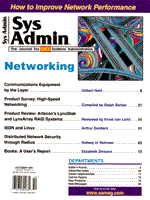
Editor's Forum
Charles Francis Richter, the American seismologist after whom the familiar Richter scale was named, was born fifty years too soon. Had he been born in 1950, rather than 1900, Richter might have become a networking guru instead of taking up seismology. Rather than describing earthquakes with a logarithmic scale, he could have been predicting the growth of the Internet and the network technologies that support it. Although numerous people have been foretelling the imminent collapse of the Internet due to its growth in recent years, we are probably still rumbling around the 1s and 2s on the could-have-been Richter scale of Internet growth (RSIG). The potential of the Internet has certainly captured the minds of multitudes of people. Some revel in the possibilities of expanded human communication, others in the latent business potential offered by the technology. Others, who serve both groups, are content to relish the growth of their Internet-related stocks. Those who feel they are too late to ride the Internet wave to fame and fortune should take heart. Remember, we are still at the lower end of the RSIG. The really big shakeups are still to come. The "Big Ones," Internet-wise, will likely occur in the area where technologies overlap, rather akin to the movement of the tectonic plates of the Earth's crust. The current Internet structure is based on the 32-bit IPv4 naming scheme. The fact that IPv4 is quickly running out of addresses is well-known. The deployment of classless interdomain routing, however, has extended the life of IPv4 by a few years. That routing scheme is allowing the foundation of the expanded address space provided by the next generation of the Internet, (formally referred to as IPv6, but affectionately called IPng in true Star Trek style) to be more thoughtfully developed and tested. The 128-bit address space of IPv6 far exceeds the foreseeable requirements for computer addresses, and intentionally so. This extra address space will combine with various other economic and social forces, propelling us into the mid-range on the RSIG. The high-speed Ethernet product survey in this issue is also testimonial to the growing needs of the network. Multimedia-enabled applications, along with the Internet and its clones (the intranet and the extranet), are demanding greater bandwidth in our LANs. Our product survey examines some of the ways of satisfying such bandwidth-hungry applications. Fast Ethernet segments and Gigabit Ethernet backbones, however, are just the beginning (an RSIG 3, perhaps). Consider having Java-enabled, SNMP-capable, network-addressable chips in your home appliances. While having such a device in my toaster has little appeal, on several occasions I have longed to be able to remotely contact an iron or a furnace to make sure that I turned them off before leaving on a trip. Add a cellular phone that doubles as an Internet-capable mobile terminal (already on the market) to the picture and you have an ideal solution to the problem of your house burning down at exactly the moment you are entrusting your last dime to that machine in Las Vegas. Such a capability must be at least a 5 on the RSIG. The robots that the futurists of a few years back predicted would be serving us will likely turn out to be a variety of handheld devices, personal digital assistants extraordinaire, if you will. Beyond RSIG 5? Truly interesting times lie ahead, particularly for those who administer the systems.
Sincerely yours,
|